Abstract
Many of the clinical features of paraproteinemia result from impairment of blood flow through the vascular tree because of blood hyperviscosity. Studies were carried out in 65 patients with serum paraproteins (31 with IgG, 25 with IgM, and 9 with IgA) to examine the relationship between the blood viscosity and the frequency of selected clinical features. The blood and plasma viscosities were measured at low rates of shear. Blood hyperviscosity was present in 91% of the patients and plasma hyperviscosity in 75% of the patients. In each of the three immunoglobulin classes both the blood and plasma viscosities increased logarithmically with the paraprotein concentration being greatest in the case of IgM. In addition, the relationship between the hematocrit and the logarithm of blood viscosity tended to be linear at any given protein concentration. In patients with very high levels of paraprotein the blood viscosity was modified by low hematocrits; the latter was below 30 in 70% of patients in whom the concentration of paraprotein was above 4 g/100 ml. The prevalence of clinical complications involving the retinal circulation, the peripheral vascular system, and the central nervous system increased markedly with increasing blood viscosity, measured at 0.18 S-1. One or more of these regions was affected in greater than 80% of patients with blood viscosity above 60 centipoise and in less than 23% of patients with blood viscosity below 40 centipoise. These observations illustrate the complex relationship between blood viscosity, concentration of paraprotein, immunoglobulin class and hematocrit, and emphasize the importance of measuring the whole blood viscosity at low rates of shear in determining the risk of vascular complications.
Full text
PDF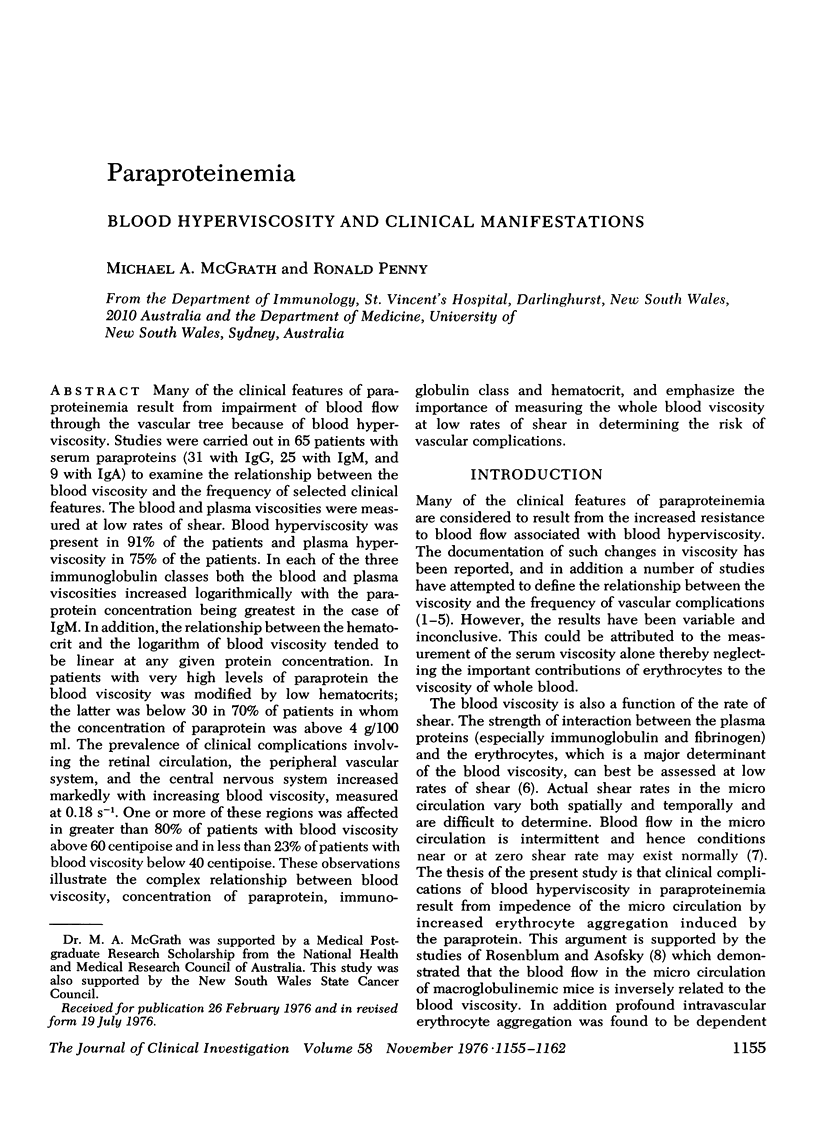
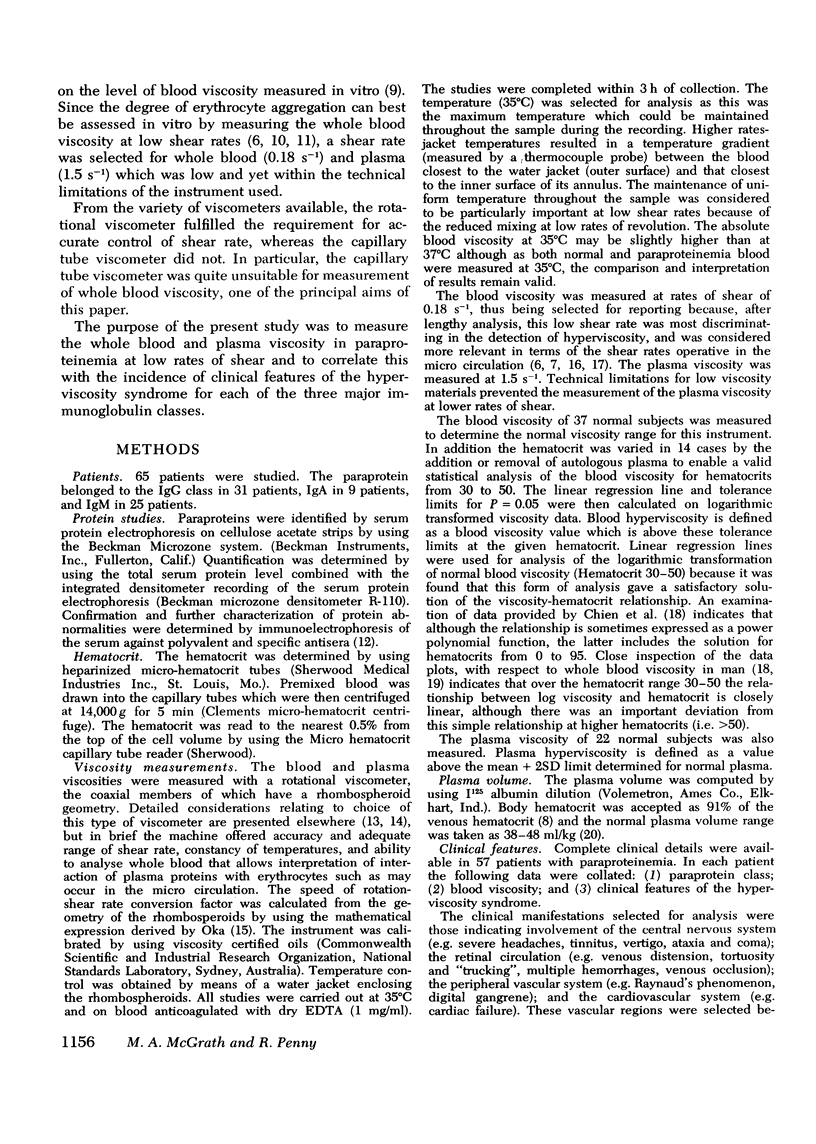
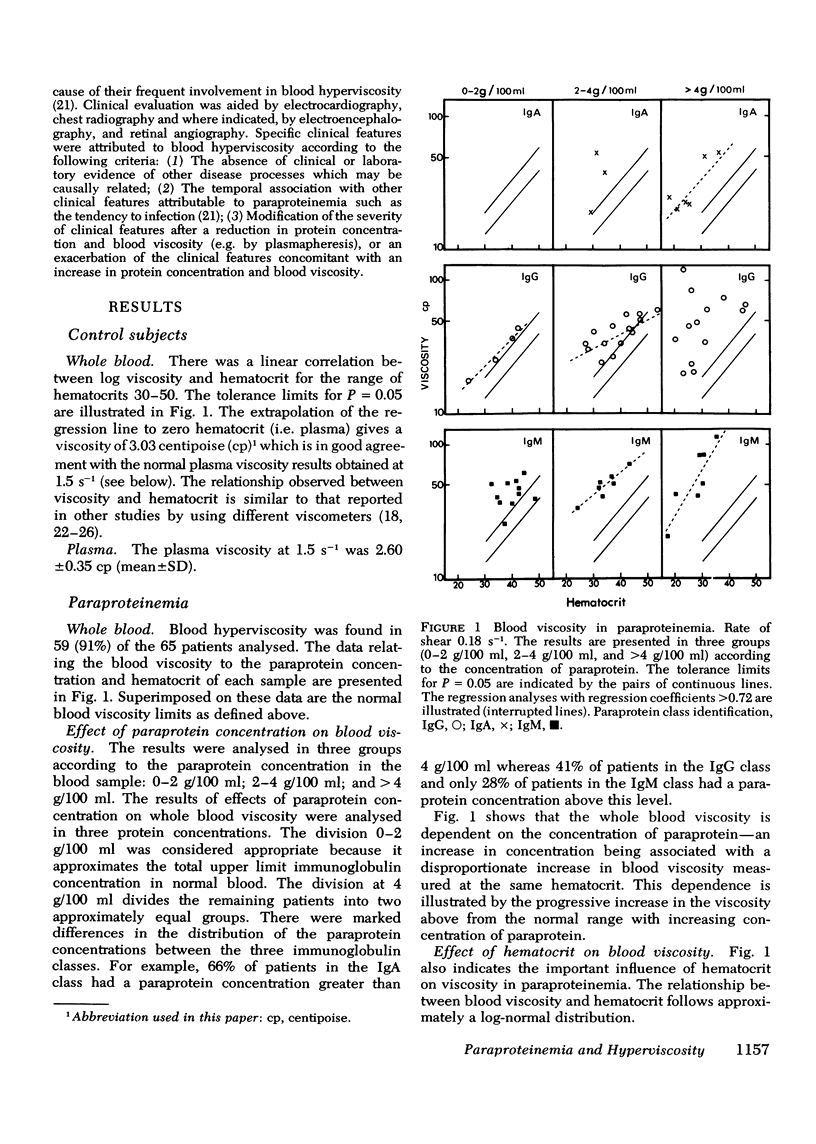
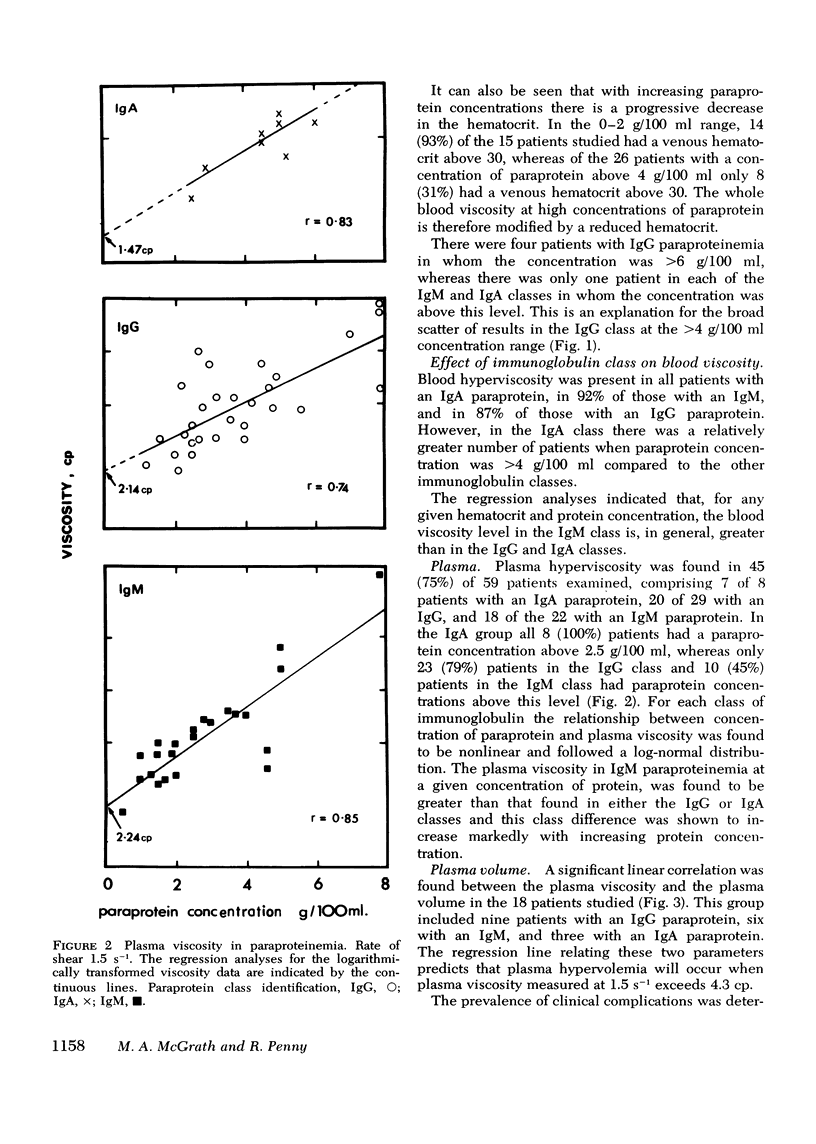
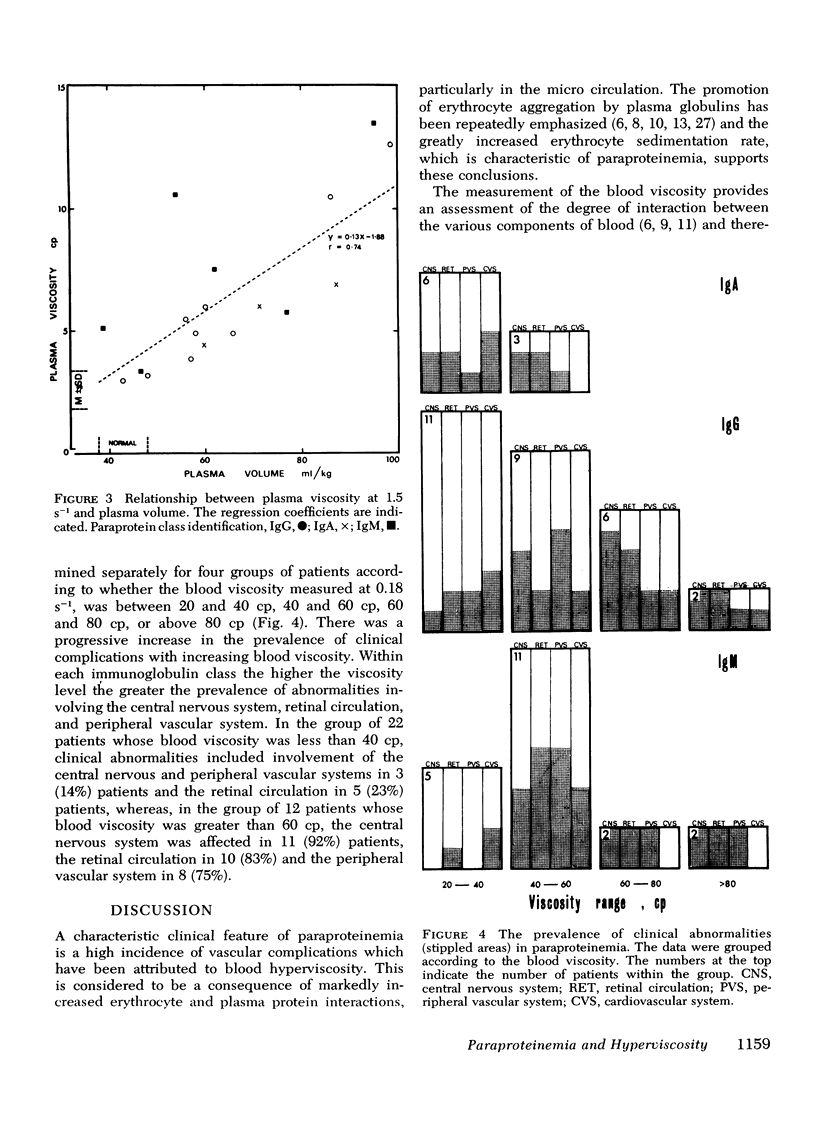
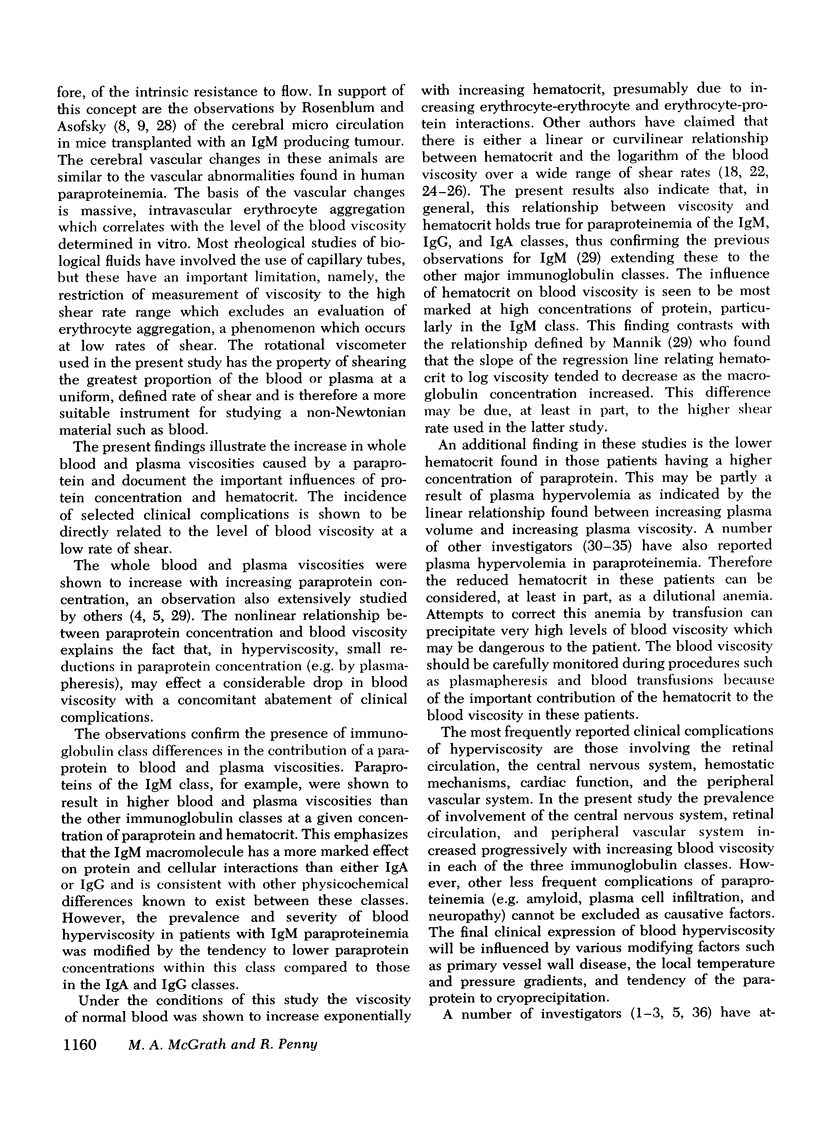
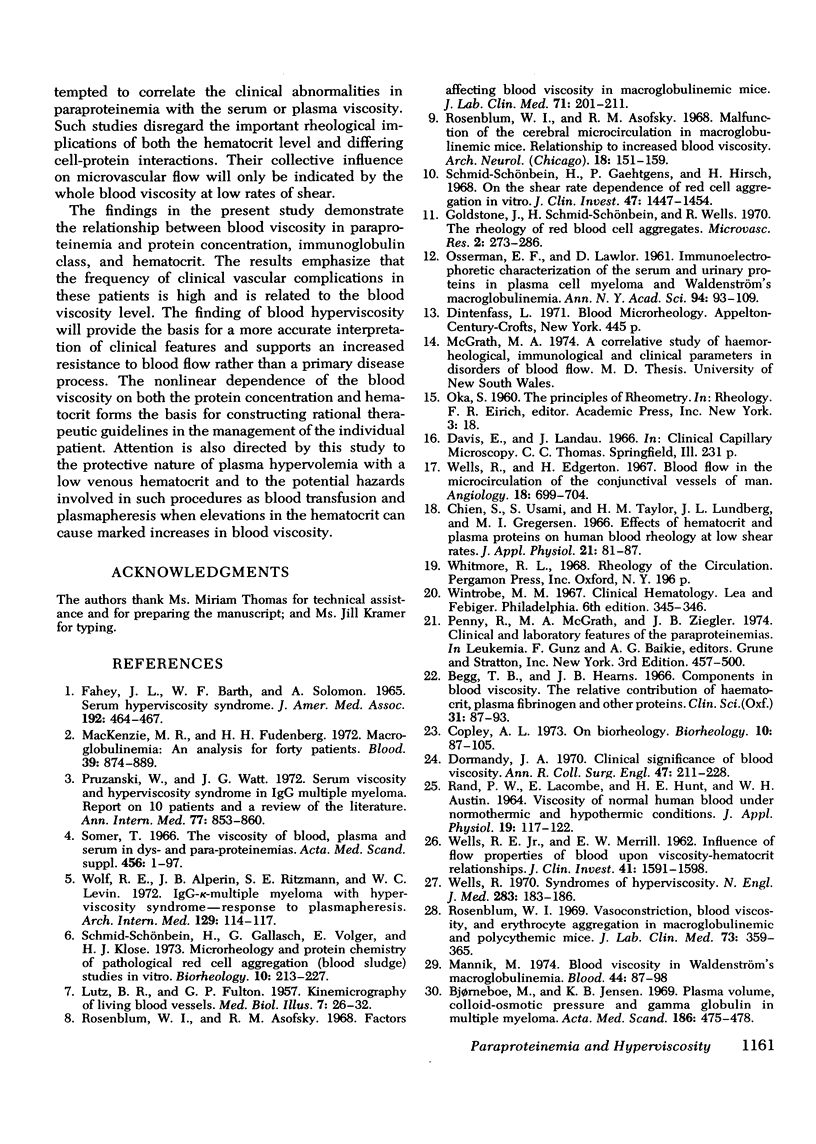
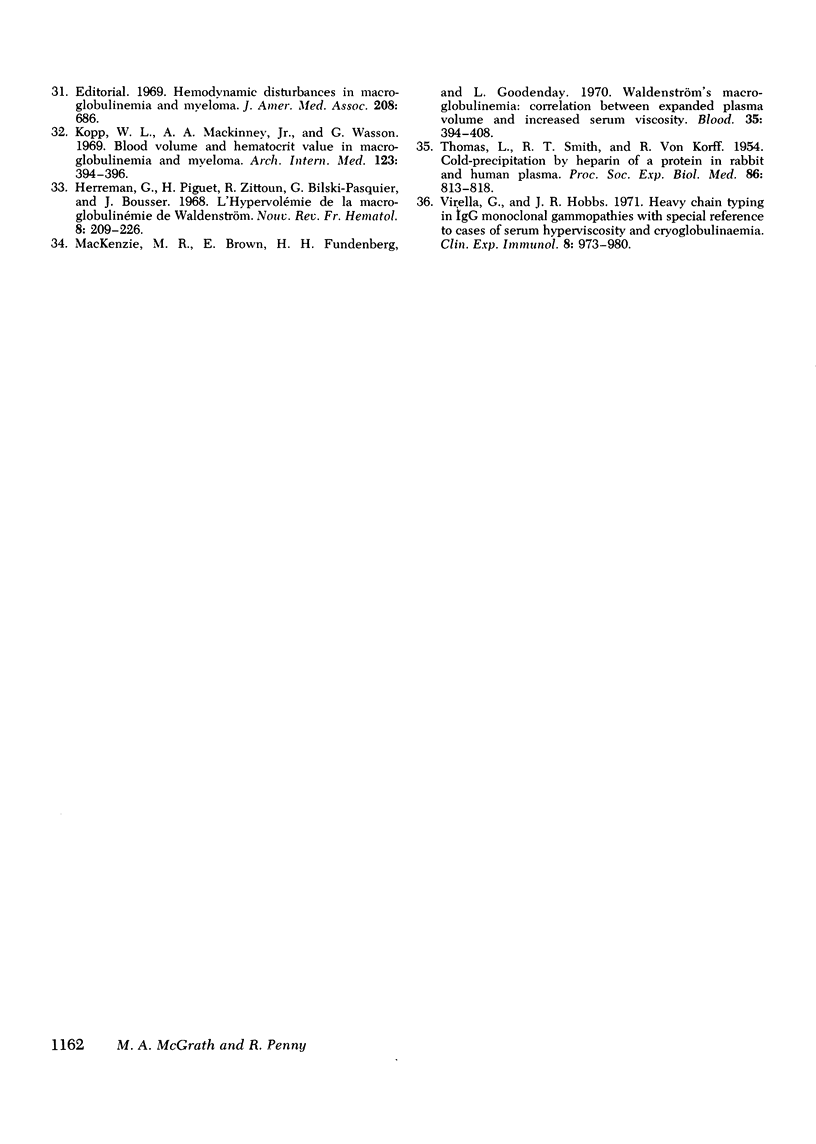
Selected References
These references are in PubMed. This may not be the complete list of references from this article.
- Begg T. B., Hearns J. B. Components in blood viscosity. The relative contribution of haematocrit, plasma fibrinogen and other proteins. Clin Sci. 1966 Aug;31(1):87–93. [PubMed] [Google Scholar]
- Bjorneboe M., Jensen K. B. Plasma volume, colloid-osmotic pressure and gamma globulin in multiple myeloma. Acta Med Scand. 1969 Nov;186(5):475–478. doi: 10.1111/j.0954-6820.1969.tb01506.x. [DOI] [PubMed] [Google Scholar]
- Chien S., Usami S., Taylor H. M., Lundberg J. L., Gregersen M. I. Effects of hematocrit and plasma proteins on human blood rheology at low shear rates. J Appl Physiol. 1966 Jan;21(1):81–87. doi: 10.1152/jappl.1966.21.1.81. [DOI] [PubMed] [Google Scholar]
- Copley A. L. On biorheology. Biorheology. 1973 Jun;10(2):87–105. doi: 10.3233/bir-1973-10203. [DOI] [PubMed] [Google Scholar]
- Dormandy J. A. Clinical significance of blood viscosity. Ann R Coll Surg Engl. 1970 Oct;47(4):211–228. [PMC free article] [PubMed] [Google Scholar]
- FAHEY J. L., BARTH W. F., SOLOMON A. SERUM HYPERVISCOSITY SYNDROME. JAMA. 1965 May 10;192:464–467. doi: 10.1001/jama.1965.03080190030008. [DOI] [PubMed] [Google Scholar]
- FULTON G. P., LUTZ B. R. Kinemicrography of living blood vessels. Med Biol Illus. 1957 Jan;7(1):26–32. [PubMed] [Google Scholar]
- Goldstone J., Schmid-Schönbein H., Wells R. The rheology of red blood cell aggregates. Microvasc Res. 1970 Jul;2(3):273–286. doi: 10.1016/0026-2862(70)90018-x. [DOI] [PubMed] [Google Scholar]
- Herreman G., Piguet H., Zittoun R., Bilski-Pasquier G., Bousser J. L'hypervolémie de la macroglobulinémie de Waldenström. Nouv Rev Fr Hematol. 1968 Mar-Apr;8(2):209–226. [PubMed] [Google Scholar]
- Kopp W. L., MacKinney A. A., Jr, Wasson G. Blood volume and hematocrit value in macroglobulinemia and myeloma. Arch Intern Med. 1969 Apr;123(4):394–396. [PubMed] [Google Scholar]
- MacKenzie M. R., Brown E., Fudenberg H. H., Goodenday L. Waldenström's macroglobulinemia: correlation between expanded plasma volume and increased serum viscosity. Blood. 1970 Mar;35(3):394–408. [PubMed] [Google Scholar]
- MacKenzie M. R., Fudenberg H. H. Macroglobulinemia: an analysis for forty patients. Blood. 1972 Jun;39(6):874–889. [PubMed] [Google Scholar]
- Mannik M. Blood viscosity in Waldenström's macroglobulinemia. Blood. 1974 Jul;44(1):87–98. [PubMed] [Google Scholar]
- OSSERMAN E. F., LAWLOR D. Immunoelectrophoretic characterization of the serum and urinary proteins in plasma cell myeloma and Waldenstrom's macroglobulinemia. Ann N Y Acad Sci. 1961 Aug 31;94:93–109. doi: 10.1111/j.1749-6632.1961.tb35535.x. [DOI] [PubMed] [Google Scholar]
- Pruzanski W., Watt J. G. Serum viscosity and hyperviscosity syndrome in IgG multiple myeloma. Report on 10 patients and a review of the literature. Ann Intern Med. 1972 Dec;77(6):853–860. doi: 10.7326/0003-4819-77-6-853. [DOI] [PubMed] [Google Scholar]
- RAND P. W., LACOMBE E., HUNT H. E., AUSTIN W. H. VISCOSITY OF NORMAL HUMAN BLOOD UNDER NORMOTHERMIC AND HYPOTHERMIC CONDITIONS. J Appl Physiol. 1964 Jan;19:117–122. doi: 10.1152/jappl.1964.19.1.117. [DOI] [PubMed] [Google Scholar]
- Rosenblum W. I., Asofsky R. M. Malfunction of cerebral microcirculation in macroglobulinemic mice. Relationship to increased blood viscosity. Arch Neurol. 1968 Feb;18(2):151–159. doi: 10.1001/archneur.1968.00470320053006. [DOI] [PubMed] [Google Scholar]
- Rosenblum W. I. Vasoconstriction, blood viscosity, and erythrocyte aggregation in macroglobulinemic and polycythemic mice. J Lab Clin Med. 1969 Mar;73(3):359–365. [PubMed] [Google Scholar]
- Schmid-Schönbein H., Gaehtgens P., Hirsch H. On the shear rate dependence of red cell aggregation in vitro. J Clin Invest. 1968 Jun;47(6):1447–1454. doi: 10.1172/JCI105836. [DOI] [PMC free article] [PubMed] [Google Scholar]
- Schmid-Schönbein H., Gallasch G., Volger E., Klose H. J. Microrheology and protein chemistry of pathological red cell aggregation (blood sludge) studies in vitro. Biorheology. 1973 Jun;10(2):213–227. doi: 10.3233/bir-1973-10214. [DOI] [PubMed] [Google Scholar]
- Somer T. The viscosity of blood, plasma and serum in dys- and paraproteinemias. Acta Med Scand Suppl. 1966;456:1–97. [PubMed] [Google Scholar]
- THOMAS L., SMITH R. T., VON KORFF R. Cold-precipitation by heparin of a protein in rabbit and human plasma. Proc Soc Exp Biol Med. 1954 Aug-Sep;86(4):813–818. doi: 10.3181/00379727-86-21241. [DOI] [PubMed] [Google Scholar]
- Virella G., Hobbs J. R. Heavy chain typing in IgG monoclonal gammopathies with special reference to cases of serum hyperviscosity and cryoglobulinaemia. Clin Exp Immunol. 1971 Jun;8(6):973–980. [PMC free article] [PubMed] [Google Scholar]
- WELLS R. E., Jr, MERRILL E. W. Influence of flow properties of blood upon viscosity-hematocrit relationships. J Clin Invest. 1962 Aug;41:1591–1598. doi: 10.1172/JCI104617. [DOI] [PMC free article] [PubMed] [Google Scholar]
- Wells R., Edgerton H. Blood flow in the microcirculation of the conjunctival vessels of man. Angiology. 1967 Nov;18(11):690–704. [PubMed] [Google Scholar]
- Wells R. Syndromes of hyperviscosity. N Engl J Med. 1970 Jul 23;283(4):183–186. doi: 10.1056/NEJM197007232830406. [DOI] [PubMed] [Google Scholar]
- Wolf R. E., Alperin J. B., Ritzmann S. E., Levin W. C. IgG-K-multiple myeloma with hyperviscosity syndrome--response to plasmapheresis. Arch Intern Med. 1972 Jan;129(1):114–117. [PubMed] [Google Scholar]


